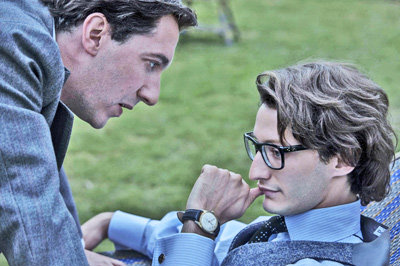Like the clothes made by Yves Saint Laurent, Jalil Lespert’s biopic of the fashion designer is a chic and elegant production. Stylishly mounted and beautifully lensed by Lespert’s roving camera, “Yves Saint Laurent,” opening July 4 at the Ritz, traces the career of the designer from his start working for Dior in the late 1950s through his death in 2008.
Young, shy and handsome, Saint Laurent (Pierre Niney) only wants to draw and design clothes. He has some success working for Dior, and upon his mentor’s death, is appointed artistic director. He hopes to keep up the tradition of excellence and find pride in his work. While some moments allow viewers to glean insight into Saint Laurent, the subject fails to be truly illuminating, indicative of what makes “Yves Saint Laurent” uneven.
Usually, films about famous people simply dramatize life achievements as if ticking off bullet points, and Lespert’s film follows this formula. One is when Saint Laurent pulls out his hair to show his stress. Another is when he pulls out a book of Mondrian paintings to find inspiration for one of his most famous dresses. Most of the film reveals Saint Laurent’s thoughts through interviews and actions. There are also a few references to socio-political events that influence (and identify) each passing decade. This approach is clunky.
While a scene in which Saint Laurent answers a friend’s personal questions is perhaps didactic, better is a dinner sequence in which he expresses his childhood at Catholic school, his indecision and his dreams and desires. It is hard to encompass a famous person’s entire life in 106 minutes, but “Yves Saint Laurent” does a mediocre job, letting audiences connect the dots even when the film feels like it is hitting the highlights or lowlights.
“Yves Saint Laurent” depicts the personal and professional crises the designer experiences, and the triumphs and tribulations on display are only moderately engaging. Saint Laurent receives his enlistment letter, which causes a breakdown. Then there is legal action against Dior; an arrest for solicitation; battles with drink, drugs and sex-club encounters; breakups, affairs and betrayals. These moments create a prismatic approach to his private life story that create an image of how he accepted his identity and the toll his fame took on him. They are all handsomely filmed, but some feel empty, as if the actors were just going through the motions.
Curiously, “Yves Saint Laurent” is told, at times, through his partner Pierre Bergé’s (Guillaume Gallienne) eyes, and the voiceovers that periodically interrupt the story can be distracting transitions. The documentary “L’Amour Fou” used Bergé’s de-accessioning of the couple’s art and possessions as a narrative strategy to look back on the significant times in their lives. The device works less here.
While there is some interest in depicting the relationship between Saint Laurent and Bergé, this part of the story seems underdeveloped. When a rift develops in their personal relationship, it is barely addressed. When their professional collaboration is on the brink of disaster, the film throbs with tension. It is interesting to see the balance of power seesaw between them, but the real crux of their relationship is explained in simple moments, such as Bergé counseling Saint Laurent about an interview or ending Saint Laurent’s toxic affair with Jacques de Bascher (Xavier Lafitte). Still, these episodes lack real emotion.
The most powerful scenes in “Yves Saint Laurent” are not the dramatic ones, but the runway sequences. There are three key fashion shows, each representing a different time and significance in the designer’s career. Lespert makes these scenes centerpieces because they not only showcase the fabulous clothes, but also provide a commentary on Saint Laurent’s life and work. When his favorite model, Victoire Doutreleau (Charlotte Le Bon), shows up with her hair cut off before a fashion show, Saint Laurent improvises a signature look at the last minute. How his relationship with Doutreleau, his muse and a woman he would marry, devolves over the course of the story is well done, and keenly emblematic of Saint Laurent’s life.
Niney is fine in the title role, and he artfully uses his body language to convey Saint Laurent’s shyness, his neuroses and his happiness. However, Niney has a few manic scenes that teeter towards melodramatic. Gallienne provides strong support playing Bergé, the man behind the man behind the clothes. He conveys so much with his eyes that it is a shame Gallienne is uninspired in the voiceovers.
“Yves Saint Laurent” does an adequate job of presenting the life and clothes of the designer, although it feels glossed over at times. Lespert is certainly respectful of his subject, but the film is merely a passable, not definitive, portrait.

